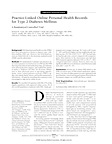A news article that quoted my response to this article was titled “Mixed Results for Personal Health Record System” which is true for the PHR being discussed here, but just for this one. For right now. The team putting together this PHR is a great team that will get great results with greater patient adoption.
Why do I say that? Well, despite the statement early in the article that “To date, there have been no large-scale studies of interventions that integrate PHRs directly with the electronic medical records (EMRs) used by patients’ own primary care physicians,” there actually have been.
There was a really good one in fact, performed at Group Health Cooperative in Seattle, WA (my review of that one is here), with great results.
The other issue that worked against the study team is patient adoption of their PHR system. This is not an artifact of PHRs in general, because other organizations, notably Kaiser Permanente and Group Health Cooperative have been seeing “hockey stick” slopes of adoption for their PHRs (see a picture of this here). Because there weren’t enough patients signed up for the Partners PHR (only 244 patients in the study, out of 6553 possible), they could not detect meaningful differences, so we don’t know if there were any real changes following the intervention or whether there is just random variation. I was informed last week, that Group Health Cooperative just passed the 50 % mark for adoption of its personal health record by the adults served in its Western Washington service area. In Eastern Washington, they are not far behind, with 42 % adoption. That’s transformational in terms of care processes.
So the next question is “why is Partners’ PHR adoption low?” It’s a great system supported by a great team, and the patients that enjoy using Group Health and Kaiser Permanente’s PHRs are really not that different in terms of the conditions they manage. The key may be in looking at the environment that most of health care still operates in. This photograph that I took recently illustrates that.
Don’t count the personal health record out just yet. There are a lot of really dedicated physicians and other experts creating great systems who will do great things when our health care system supports the therapeutic potential of their work as much as it does that of the imaging suite. Fortunately in 2008, we now have evidence that we can get great results by involving patients in the use of health information technology to improve their health.
